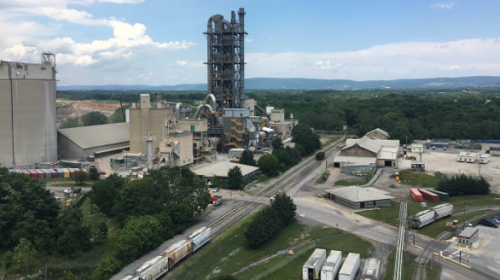Holcim (US) staged a ribbon-cutting ceremony late last month to cap a two-year Hagerstown, Md., cement plant modernization. The company underscored a clinker capacity increase upward of 200,000 tons annually, plus emissions controls abiding new Environmental Protection Agency National Emission Standards for Hazardous Air Pollutants (NESHAP) thresholds.
“A cornerstone of the regional community for 113 years, we recognize the importance of this facility to the Hagerstown community,” said LafargeHolcim U.S. Cement CEO John Stull. “Our investment to modernize clinker production represents continued commitment to our customers and local manufacturing. The facility will continue to be a strong and reliable partner to the community for many more years.” Throughout the project, he added, equipment and process improvements supported approximately 100 local plant and 300 construction jobs, and were completed with no lost time injuries.
The Hagerstown mill is a principal part of the Mid-Atlantic region cement supply chain, and especially serves concrete customers in western Maryland, Baltimore and Washington, D.C. It has provided powder for concrete at the Lincoln Memorial reflecting pool in Washington, D.C.; Dulles International Airport runways; and, Woodrow Wilson Bridge, the Interstate 95 Maryland-Virginia link south of the District of Columbia.
In addition to the capacity boost, plant upgrades will see major reductions in emissions of particulate matter, 75-plus percent; nitrogen oxides, 60-plus percent; and sulfur dioxide, approximately 50 percent. “Investing in the environment is critical for the health and long-term viability of the communities where we operate,” affirms Hagerstown Plant Manager Olivier Terver. “We are proud that the facility will set the standard in safe and environmentally responsible clinker production.”
The emissions reductions meet a deadline set in a 2012 EPA and Portland Cement Association agreement finalizing the NESHAP rule for cement plants. PCA described the plan in terms that played out at Holcim (US) Hagerstown: “[The] rule strikes the right balance in establishing compliance limits that, while still extremely challenging, are now realistic and achievable. PCA and EPA agreed that the revised standards and compliance period are essential to preserving jobs at domestic cement facilities, providing direct support for an American manufacturing industry that is critical to our nation’s infrastructure. PCA supports meeting the demand for portland cement through environmentally and socially responsible business practices, which have been implemented for decades by our member companies in their local communities.”
Silo perspective of the Hagerstown operation, along with a view of one of the mill’s least accessible aspects: the rotary kiln burner tip (inset).
PHOTOS: Holcim (US)

John Stull and Olivier Terver (fifth and fourth from right) dedicate a modernization project to sustain the strong Mid-Atlantic market presence of Holcim (US).

